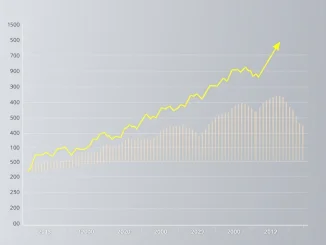
Hold onto your hats, crypto enthusiasts! This week is shaping up to be a potentially volatile one for the crypto market, and it’s all eyes on the economic calendar. Why? Because a trio of critical U.S. economic data releases are on the horizon, and they could significantly sway the direction of Bitcoin, Ethereum, and the entire digital asset space. Let’s dive into what’s coming and what it could mean for your portfolio.
Decoding the Week’s Key Economic Events and Their Crypto Impact
We’re not just talking about any run-of-the-mill data drops. This week’s schedule features inflation gauges and employment figures – the very metrics that central banks, like the Federal Reserve, are laser-focused on when making decisions about interest rates and monetary policy. And as we know, what the Fed does, the crypto market often feels – sometimes dramatically.
Here’s a breakdown of the key economic events to watch:
- Wednesday, March 12 – 12:30 UTC: U.S. CPI (February)
- Thursday, March 13 – 12:30 UTC: U.S. PPI (February)
- Thursday, March 13 – 12:30 UTC: U.S. Initial Jobless Claims
Let’s unpack each of these and understand why they matter, especially in the context of the crypto market.
Why is Wednesday’s CPI Data a Potential Game Changer for Crypto?
First up, we have the Consumer Price Index, or CPI data. Think of CPI as the everyday inflation report card. It measures the average change in prices consumers pay for a basket of goods and services. It’s a primary indicator of inflation, and inflation is the arch-nemesis of purchasing power. Why should crypto investors care?
Here’s the connection:
- Inflation and Interest Rates: High inflation often prompts central banks to raise interest rates to cool down the economy.
- Interest Rates and Risk Assets: Higher interest rates can make riskier assets like cryptocurrencies less attractive compared to safer, yield-bearing investments like bonds.
- Market Sentiment: Unexpectedly high CPI figures could trigger fears of aggressive rate hikes, leading to a potential sell-off in the crypto market. Conversely, lower-than-expected CPI might be seen as a positive, suggesting inflation is under control and potentially paving the way for a more dovish monetary policy.
What to watch for in the CPI release: Keep an eye on both the headline CPI (all items) and the core CPI (excluding volatile food and energy prices). Core CPI is often seen as a better gauge of underlying inflation trends. A significant deviation from expectations in either direction could lead to increased volatility in Bitcoin and other cryptocurrencies.
Thursday’s PPI Data: A Sneak Peek into Future Inflationary Pressures?
Next, on Thursday, we get the Producer Price Index, or PPI data. While CPI looks at consumer prices, PPI tracks inflation from the perspective of producers – the folks who make the goods and provide the services we eventually buy. Why is this important for crypto?
PPI as a Leading Indicator:
- Early Inflation Signals: Changes in producer prices can often foreshadow future changes in consumer prices. If producers are paying more for raw materials and production, they’re likely to pass those costs onto consumers eventually.
- Impact on Corporate Earnings: Rising producer prices can squeeze corporate profit margins, potentially impacting stock prices. And as we’ve seen, traditional stock markets and the crypto market often exhibit correlations.
- Market Sentiment and Future Expectations: A higher-than-expected PPI reading could reinforce concerns about persistent inflation and potentially strengthen the case for further interest rate hikes, impacting risk assets like crypto.
What to look for in the PPI report: Similar to CPI, pay attention to both headline and core PPI. A rising PPI can add to the inflationary narrative and potentially dampen investor enthusiasm for cryptocurrencies in the short term.
Thursday’s Jobless Claims: Is the Labor Market Cooling Down?
Also on Thursday, alongside PPI, we have the U.S. Initial Jobless Claims report. This data point tells us how many people are filing for unemployment benefits for the first time. It’s a timely indicator of the health of the labor market. Why does this matter for crypto?
Jobless Claims and Economic Health:
- Labor Market Strength and Economic Growth: A strong labor market generally supports economic growth. Conversely, rising jobless claims can signal a weakening economy.
- Central Bank Policy: The Federal Reserve considers labor market conditions when setting monetary policy. A weakening labor market could potentially lead to a less hawkish stance, which could be positive for risk assets.
- Risk Appetite: A robust labor market can boost consumer confidence and overall risk appetite, potentially benefiting the crypto market. However, an overly strong labor market could also fuel inflation concerns.
Interpreting Jobless Claims: Economists and market participants will be looking at whether jobless claims are trending upwards, downwards, or remaining stable. A significant jump in initial jobless claims could be interpreted as a sign of economic weakness, potentially influencing market sentiment and impacting crypto prices.
Navigating the Week: Actionable Insights for Crypto Investors
So, how should crypto investors approach this week of crucial economic events?
- Stay Informed: Keep an eye on the actual data releases and market reactions. Reputable crypto news sources will provide real-time updates and analysis.
- Manage Risk: Be prepared for potential volatility. Consider adjusting your portfolio risk levels if you are concerned about market swings.
- Zoom Out: Remember that short-term market fluctuations are normal. Focus on your long-term investment strategy and the fundamental drivers of the crypto market.
- Don’t Panic: Economic data releases are a regular part of the market cycle. Avoid making impulsive decisions based on short-term price movements.
Conclusion: Prepare for Potential Crypto Market Movement
This week’s U.S. CPI data, PPI data, and jobless claims are not just numbers on a screen; they are potential catalysts for movement in the crypto market. Understanding the significance of these economic events and how they might influence investor sentiment and central bank policy is crucial for navigating the week ahead. Stay vigilant, stay informed, and remember that knowledge is power in the world of crypto investing. Will we see a surge or a dip? Only time will tell, but being prepared is half the battle!



